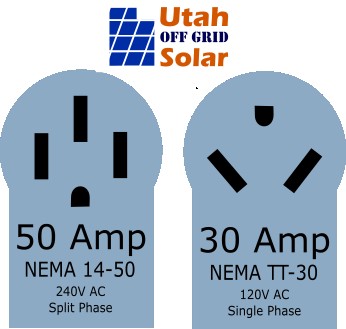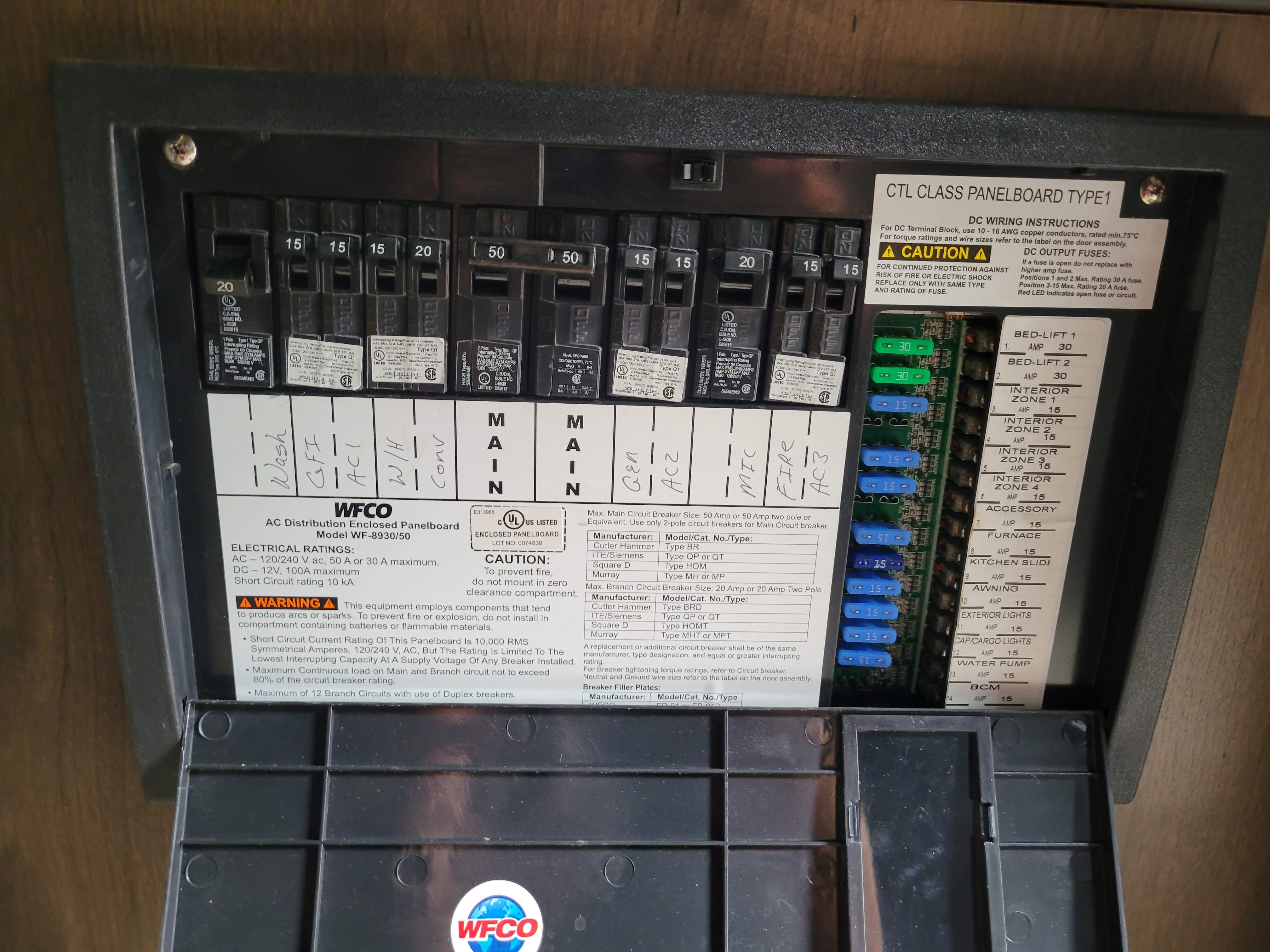Part of: Guides
30 Amp vs 50 Amp Service in Campers
RVs, Trailers, Fifth Wheels, and Campervans almost always have the ability to connect to utility power. And almost all of them have either a 30 amp or 50 amp service connection.

You can easily tell which one you have by looking at the plug at the end of your shore power cable, or at your power distribution panel. Refer to the image above to see which type you have.
Likewise, a 30 amp service will have a power distribution panel that has one 30 amp breaker at one end of the row of breakers, and a 50 amp panel will have two joined 50 amp breakers in the middle of the row of breakers.
30 Amp Service – 1 Pole
30 amp service is very simple, consisting of three wires, live, neutral, and ground. There are some excellent resources (here) that can go into great depth with how residential power works in North America, but I’ll try to keep this as simple as possible.
Current flows between the live and neutral wires, and the total current used by every device connected to the AC power system must be less than 30 amps.
50 Amp Service – 2 Poles

Now where things get a little bit tricky is 50 amp service. This type of service has two power poles, we’ll call them L1 and L2, as well as neutral and ground.
Power still flows between L1 and Neutral and L2 and Neutral, but since L1 and L2 are 180 degrees out of phase, we can have 50A flow through L1 and 50A flow through L2 at the same time. As an example, if at any given instant there is 10A flowing through L1, and 10A flowing through L2, since L1 and L2 are perfectly out of phase, that means that 10A must flow into neutral from L1, and 10A must flow out of neutral into L2. This means that the maximum current through neutral is 50A, and can only be reached if one live leg is drawing 50A and the other live leg is drawing nothing.
Since 50A service in campers still only uses 120v appliances, a single 120V inverter can be used to power the entire trailer. It will just must not be able to provide more than 50 amps.
Where many 50 amp inverter installations go wrong
Most readily available inverters or inverter/chargers create single-phase 120V power. Since 50 amp service uses two legs, sometimes inverters may be used to energize only one leg of the system, which means that only about half of the circuits are energized. In some trailers this can be OK, but for most it is not desirable.
What I’ve seen done from time to time is the installation of two inverters. This is potentially dangerous. Most inverters for campers or off-grid systems do not have the ability to synchronize their output, as such, you will have two 120V AC power sources that are at some unknown phase relative to one another, and isolated from one another.
For instance, imagine you’re using two 5 kVA inverters, and they happen to be completely in phase, and connected via L1, L2, and Neutral. What will happen if you draw the maximum power, around 42 amps, on each inverter? L1 will see 42 amps, which is fine, L2 will see 42 amps, which is also fine, however Neutral will see 42+42=84 amps. Normally such a condition would not be possible, since L1 and L2 are each protected by a 50 amp circuit breaker, and the neutral current is only equal to the difference between the current on L1 and current on L2. Since L1 and L2 are in phase now, the current in neutral is equal to the sum of the currents on L1 and L2. This leads to an overcurrent on neutral, and in the worst case, could cause a fire!
Many installations use 3kVA inverters, which are capable of a maximum of 25 amps. These are typically safe for this application, since they can not produce more than ½ the maximum rated current.
50 Amp Inverter layouts
So, while 50 amp systems are a little bit more complicated than 30 amp systems, they can still be connected relatively easily to an inverter, or inverters. As discussed above, there are several inverter system options available for 50 amp campers.
Dual Inverters
One inverter for each leg is viable, so long as each inverter does not exceed 3 kVA. Units with a built in transfer switch are typically suitable for this application, but be sure that no more than one unit is charging batteries from utility power at a time.
Single Inverter
A single inverter can also be used to power the entire system, since all appliances are still only 120V. A single inverter solution requires an external transfer switch designed to switch both poles & neutral.
Purpose Built Inverters
Victron offers a series of inverters, called 2x120V inverters which have a built-in 50 amp automatic transfer switch and utility charger. These units are the simplest to install, however the Victron ecosystem is not very affordable compared to other options, and their product ecosystem is very vast, and not easy for beginners to understand.